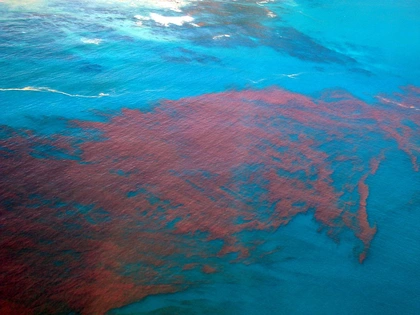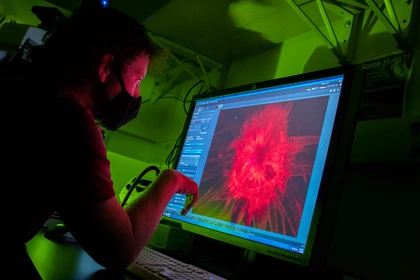Seed funding promotes bold research initiatives

Launched in 2015, Carnegie Science Venture Grants program was designed to provide seed funding for high-risk, enterprising research projects that eliminate silos and break disciplinary boundaries.
Since its inception, 23 grants have been awarded, launching several exciting initiatives. Past successes include unraveling a long-standing mystery about how genetic material is organized in a diverse group of algae called dinoflagellates and the development of a framework for understanding the interiors, and potential habitability, of super-Earths.

Recently, Carnegie biologists Phillip Cleves and Yixian Zheng partnered with Jianhua Wang, who oversees the Earth and Planets Laboratory’s nanoscale secondary ion mass spectroscopy facility to probe 120 coral genes that could be involved in enabling coral polyps to obtain nutrients from their symbiotic algae. This relationship is fundamental to coral health but is threatened by ocean warming due to climate change. Using this sophisticated equipment, the researchers hope to reveal the molecular processes by which food is supplied by the algae to the coral and how this important function may be lost during bleaching events.
"The Carnegie Venture Grant program provides amazing opportunities for Carnegie researchers to step out of their comfort zones and pursue new passions. For my lab, we have developed new collaborations to use population genomic approaches to find genes that coral may use to survive climate change, and we are also developing new methods to measure how coral metabolism changes during heat stress, which may be a key molecular mechanism underlying the collapse of coral ecosystems worldwide,” explained Cleves. “Without the support of Carnegie and the Venture Grant program, we would not have gone in these new directions, and as a result, my lab would be lesser for it. The Venture Grant program is an essential part of what makes Carnegie's biology research great."

Cleves has been awarded several Venture Grants for his marine biology research, including another 2022 project, in collaboration with plant scientists Arthur Grossman and Frej Tulin that is improving our knowledge of kelp reproductive biology. By better understanding the mechanism by which kelp generates and releases spores into the environment, scientists can improve our ability to develop kelp as an aquaculture crop, as well as inform rewilding conservation efforts.
“Every year, our staff and postdocs put forward interdisciplinary approaches to address big scientific questions and solve research challenges,” said John Mulchaey, Carnegie’s Deputy for Science and Observatories Director, who oversees the program. “It’s always so difficult to narrow the field.”
The interdisciplinary focus of the program enables people to tap into the expertise of Carnegie colleagues to answer long-standing questions. For example, plant biologists Heather Meyer and David Ehrhardt partnered with astrobiologist Andrew Steele to understand how plants form and maintain “molecular memories.” Ecologist Anna Michalak, evolutionary geneticist Moises Exposito-Alonso, and microbiome specialist William Ludington received funds to conduct a first-of-its-kind study to understand how climate change and evolutionary pressures are driving genetic changes in the phytoplankton species that form dangerous algal blooms.

Other Venture Grant efforts cross geographic, rather than disciplinary, boundaries to bring experts in similar fields who work at different Carnegie campuses—or experts from partner organizations—together to push the boundaries of their research. For example, Earth and Planets Laboratory theorist Peter Gao and Observatories theorist Tony Piro are working together to develop a method for discovering exomoons using evidence of lunar volcanism.
“Our Venture Grant allowed us to launch a new program to study the internal structure of super-Earths using state-of-the-art facilities at the National Laboratory, leading to high-impact publications on melting and density at extreme pressure,” said Earth and Planets Laboratory Staff Scientist Yingwei Fei. “Through the program we have established close collaborations with scientists at the National Laboratories and continue projects focusing on materials properties under extreme conditions.”